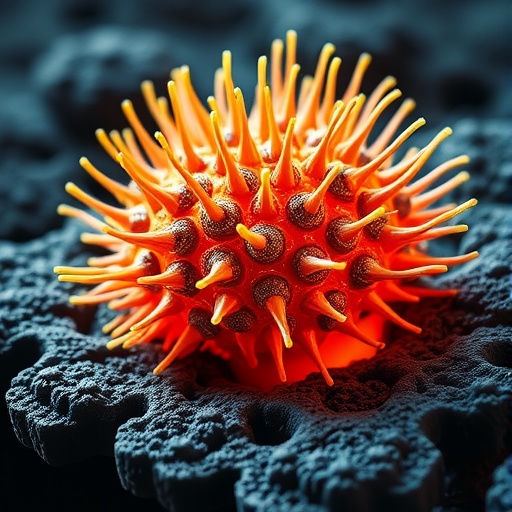In the quest for more efficient energy storage technologies, researchers have been exploring innovative materials that can enhance the performance of batteries. The latest breakthrough comes from a team of scientists who have developed a unique cathode material for aqueous zinc-ion batteries, inspired by the intricate architecture of sea urchins. This new material, which features a hierarchical structure and is doped with silver (Ag), promises to provide higher stability and better performance compared to conventional materials.
At the heart of this study is manganese dioxide (MnO2), a compound that has long been recognized for its potential in battery applications due to its abundance and electrochemical properties. However, traditional MnO2 cathodes often suffer from structural instability and poor cycling performance, particularly in aqueous environments. This is where the newly designed sea urchin-like hierarchical structure comes into play, as the unique geometry allows for enhanced ion transport and structural integrity during charge-discharge cycles.
The researchers meticulously engineered the Ag-doped MnO2 material by employing advanced synthesis techniques that facilitate the development of its unique morphology. The hierarchical structure mimics the spiky exterior of a sea urchin, which not only provides a larger surface area for electrochemical reactions but also contributes to mechanical stability. This design is crucial in preventing the collapse of the cathode structure during repeated cycling, a common challenge in energy storage systems.
One of the remarkable aspects of this study is the incorporation of silver into the MnO2 matrix. Silver is known for its excellent conductivity, and its presence in the cathode material significantly improves electronic transport. This enhancement is vital for achieving high current densities during battery operation, thus allowing the zinc-ion batteries to deliver superior energy capacity. As a result, the combination of silver doping and hierarchical structuring marks a significant advancement in the field of battery materials.
In terms of performance, the Ag-doped MnO2 cathode has exhibited impressive results in various electrochemical tests. The research team conducted extensive cycling stability assessments, which demonstrated that the designed material maintains its capacity over extended periods, a critical metric for any commercial battery. The stability and cycling performance are pivotal factors that could determine the feasibility of this new cathode material for practical applications in real-world scenarios.
The aqueous zinc-ion battery technology represents a promising alternative to conventional lithium-ion batteries, particularly in large-scale energy storage applications. Zinc, being more abundant and less toxic than lithium, offers a sustainable solution to meet the growing demands of energy storage. The development of stable cathodes like the one discussed can help pave the way for the widespread adoption of this technology, enhancing the usability of renewable energy sources.
Researchers believe that with further optimization and scaling, this sea urchin-inspired Ag-doped MnO2 cathode could significantly improve the overall efficiency and lifespan of zinc-ion batteries. This breakthrough not only holds promise for enhancing energy storage solutions but also contributes to reducing the environmental impact of battery production and usage.
Moreover, this innovative cathode design could catalyze further research into hierarchical structures in battery technologies. The principles applied in this study may inspire the development of new materials and architectures not just for zinc-ion batteries, but for various other types of batteries, encouraging a wave of innovation in energy storage systems.
This research adds to the growing body of evidence demonstrating the potential advantages of alternative battery chemistries. As the demand for better energy storage solutions continues to rise, the need for creative and effective materials has never been more pressing. The findings from Liu et al. serve as a beacon of hope for researchers and industries committed to exploring sustainable solutions.
Moreover, the move toward sustainable and environmentally friendly battery technologies is not just a trend but an essential shift for future development. The utilization of zinc, a safer and more abundant element, alongside innovative materials like Ag-doped MnO2, marks a significant step in reducing our reliance on lithium sources and their associated environmental risks.
As the researchers continue to refine their approach and explore the full range of possibilities offered by this new material, the future of energy storage appears brighter than ever. The successful integration of physics, chemistry, and innovative engineering exemplifies how interdisciplinary efforts can result in meaningful advancements in technology.
This breakthrough is likely to stimulate conversations in energy storage sectors and among policymakers alike, as it emphasizes the urgent need to transition towards more sustainable energy solutions. The development of efficient, stable, and low-impact battery materials aligns perfectly with global sustainability goals, positioning this research as a key contributor to combating the climate crisis.
In conclusion, the development of sea urchin-like hierarchical structured Ag-doped MnO2 for zinc-ion batteries opens up new avenues in battery technology, merging innovation with sustainability. Researchers Liu, Wang, and their colleagues are at the forefront of this transformation, pushing boundaries to create more reliable, efficient, and environmentally friendly energy storage solutions that could shape the future of power.
Through this ongoing research, the team hopes to push the boundaries of what is possible in the field of battery technology, contributing not only to scientific understanding but also to the practical realities of a more sustainable future.
Subject of Research: Development of Ag-doped MnO2 Cathode Material for Zinc-ion Batteries
Article Title: Sea urchin-like hierarchical structured Ag-doped MnO2 cathode material for stable aqueous zinc-ion batteries
Article References: Liu, B., Wang, J., Wang, B. et al. Sea urchin-like hierarchical structured Ag-doped MnO2 cathode material for stable aqueous zinc-ion batteries. Ionics (2025). https://doi.org/10.1007/s11581-025-06701-7
Image Credits: AI Generated
DOI: https://doi.org/10.1007/s11581-025-06701-7
Keywords: zinc-ion batteries, Ag-doped MnO2, energy storage, hierarchical structure, sustainability, electrochemistry, battery technology




